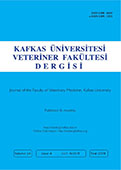
This journal is licensed under a Creative Commons Attribution-NonCommercial 4.0 International License
Kafkas Üniversitesi Veteriner Fakültesi Dergisi
2018 , Vol 24 , Issue 4
Moraxella ovis and Mycoplasma conjunctivae Isolation from an Ovine Infectious Keratoconjunctivitis Outbreak and Fortified Treatment Approaches
1Department of Microbiology, Faculty of Veterinary Medicine, University of Kafkas, TR-36100 Kars - TURKEY2Department of Internal Medicine, Faculty of Veterinary Medicine, University of Kafkas, TR-36100 Kars - TURKEY
3Department of Ophthalmology, Faculty of Medicine, University of Kafkas, TR-36100 Kars - TURKEY
4Department of Surgery, Faculty of Veterinary Medicine, University of Kafkas, TR-36100 Kars - TURKEY DOI : 10.9775/kvfd.2018.19572 The aim of this study was to determine the etiology of naturally occurring infectious keratoconjunctivitis (IKC) outbreak observed in a Tuj sheep herd rearing semi-intensively and to try fortified treatment options in symptomatic sheeps. Conjunctival samples from 42 sheep with keratoconjunctivitis were collected aseptically using sterile cotton swabs. All swab were cultivated for bacterial isolation. To test treatment options symptomatic animals were randomly divided into 3 groups each were composed of adult ewes. The first group (n=13) was treated with the subconjunctival administration of penicillin G potassium (250.000 IU/animal), the second group (n=14) was treated with oxytetracycline and polymyxin B sulfate, and the third group (n=15) was treated with amikacin sulfate (diluted with isotonic NaCl to 25 mg per mL), ceftriaxone disodium and fluconazole (2 mg/mL) combination. As the results of the bacteriological examination, 36 (85.71%) of 42 conjunctival samples were found positive for Moraxella ovis. Also, Mycoplasma conjunctivae was identified in 3 (7.14%) conjunctival samples positive for M. ovis. After treatment, 84.6% (11/13) of the first group; 71.42% (10/14) of the second group and all animals in the third group were observed to be healed. This study demonstrated that M. ovis was the primary pathogen causing IKC in Tuj sheeps and M. conjunctivae was the second rank. The combination of amikacin sulfate, ceftriaxone disodium and fluconazole have been identified as the most effective treatment option of IKC in sheep. Keywords : Keratoconjunctivitis, Sheep, Moraxella ovis, Mycoplasma conjunctivae










